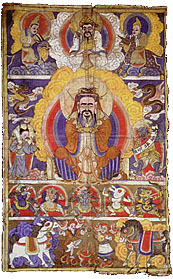 |
|
|
 |
|
|
Dongba
Illustration from the Naxi People Qing
dynasty (1644�1911) or Republican period (1912�1949), undated, 1930s or earlier Illustration of Deities and Demons
2
linen panels stitched together to form 1 panel; unmounted; approx. 102.0 x 62.0
cm Inventory number: 111 bao-1 Naxi
beliefs grew out of the shamanistic Bon religion of pre-Buddhist Tibet; they
also were incorporated elements of Daoism and Tibetan Buddhism.� The dongba (priests) imitate Bon monks in
dress and action; they are often also accomplished shamans, medicine men, scholars,
artists, craftsmen, dancers, and singers.�
The Naxi believe that their dead proceed automatically and directly to
hell.� The souls of the deceased must
therefore be led back out from the infernal depths toward heaven by the dongba
or ritual specialists during the performance of elaborate funerary rites;
pictorial illustrations are an integral part of� these rituals. This
Illustration
of Deities and Demons is divided into four registers.� The topmost contains a triad of benevolent
deities within a celestial realm.� The
seated and haloed principal deity in the second register is flanked by a scribe
and a demon holding a banner containing an ambiguous phrase in Chinese
characters, shan
e fei ming, which may be translated as "good and evil cannot be
discerned" or "good and evil are not [necessarily] clear"; a
winged serpent and a winged dragonlike beast hover at the upper corners.� The third register has five animal-headed,
human-bodied creatures portrayed in a stylized stance.� The lowermost register shows a pair of human
figures perched above flames and accompanied by two horses.� Such a picture probably would have been hung
during religious ceremonies conducted by the dongba and rolled up after
each use. |
 |